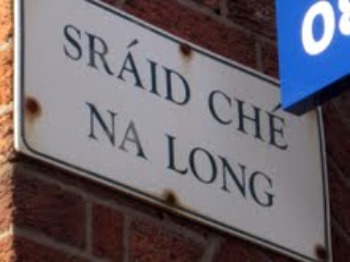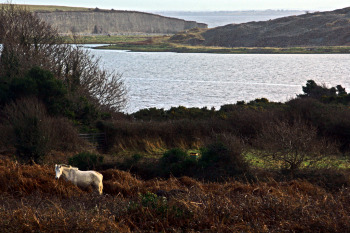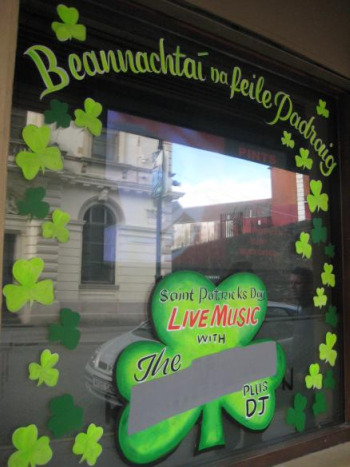Almost three years ago, I was on a bus heading from the airport in Dublin to city center. As an eager tourist, I listened in politely on the conversations around me, smiling at the jovial ups and downs of the Irish accent. Suddenly, a conversation caught my attention that I couldn’t quite understand. I stared intently, blatantly ignoring all of my manners, and allowed my jaw to drop slightly as I strained to hear just one word I could comprehend.
But no matter how long I listened, I would never have understood. They were speaking Gaeilge (GAYLE-guh), or Irish. No, it’s not a very strong accent; it’s actually a completely separate language. Call me an ignorant American, but I thought the language was dead; quite to the contrary as I find out. Having lived in Gaillimh (GAHL-yiev) or Galway, as it’s commonly known to us Westerners, for the past three months, I’ve had a chance to get much more intimate with the Irish language and those who speak and study it.
 History of the Irish Language
History of the Irish Language
Irish (or Irish Gaelic, Gaelic or Gaeilge) is the classical language spoken throughout history by the Irish people. Irish is a Celtic language which has been traced back as far as 1200 BC. The language is an official language of the Republic of Ireland and in certain counties, is still used for official day-to-day use.
The language has seen a tumultuous history, which accounts for the limited use today. During the end of British rule of most of the Emerald Isle, Irish was banned and most native Irish speakers were pushed to the western half of the island. As a result, most of the prominent Irish speaking regions, or the Gaeltacht (Gahl-TACHT) areas, lie along the West Coast.
After what we now know as the Republic of Ireland established independence in 1922, speaking Irish was encouraged (and sometimes required as in the case of certain civil positions and public offices). Though this requirement is no longer in existence, most school children are required to take Irish language courses and speak Gaeilge at least a bit.
Where to hear spoken Irish
You can hear Irish spoken in most of Ireland (including Northern Ireland, despite popular belief) but some places are better than others. As mentioned above, Gaeltecht areas are regions in Ireland where Irish is still the predominately spoken language. In these regions, you are likely to see many signs in Irish (and sometimes exclusively in Irish) and find many restaurants, pubs and coffee shops where Irish is the main spoken language.

Specifically, some towns on the West Coast where you are likely to run into someone speaking Irish include Galway, the Aran Islands (Árann, pronounced AH-ren) and Spiddal (An Spidéal, pronounced Ahn Sp-IH-duhll) which are all in County Galway and Gweedore (Gaoth Dobhair) in County Donnegal (Dhún na nGall, pronounced Dawn-nee-GAHL). If you head into any of these towns you are guaranteed to find street signs in Irish and several restaurants and pubs whose names may look difficult to pronounce. If you ask around, the locals can usually point you in the best direction to hear native speakers.
People of all ages and backgrounds speak Irish. Most children grow up learning Irish in school and therefore often times know the language better than their parents (who may be out of practice unless they speak the language commonly with friends or family). Most places where Irish is spoken regularly, you will find it is intermixed with English and people will often go in and out of using Irish depending on who is around and what the conversation is about.
If you find a group of old Irish men at a pub speaking Irish, this will usually be the best way to experience the language as you can listen in without acting too creepy. Often times, you will find friends walking (for example, along the Salthill Promenade near Galway) and talking and though I don’t suggest following behind to listen in, it is an option. If you’re not in the stalking business, good ways to hear Irish in the western half of the country are to tune into the radio or news.
Raidió Teilifís Éireann (or RTÉ – the National Television and Radio broadcaster) has both a television and radio station broadcasting exclusively in Irish. The radio station, RTÉ Raidió na Gaeltachta, is available on 92-94 FM and has a variety of talking programs throughout the day. TG4, the all-Irish television station, is another place to turn if you’re desperate for some Gaeilge.

If you find access to the television or radio hard to come by, there are still two more viable options for you. The first is to head to mass at one of the local cathedrals. Some masses (again, you’ll have to ask around on this, depending on where you are) will say all, or part, of mass in Irish and most churches will say at least the “Our Father” in Irish.
Going to mass as a non-Catholic is absolutely fine, just follow those around you (sit, stand, sit, stand) or if you’re uncomfortable, stand in the back and watch from a distance. Do not, however, take communion if you’re not Catholic.
If you’re not comfortable in a church (I understand) my last suggestion is to head to a traditional Irish music session. Though hearing Irish is not usually commonplace at a trad session, you will hear great traditional music, and likely will drink enough Guinness to forget you were looking for Irish speakers to begin with.
Finding a trad session is like finding a pub in most cities in the west and most pubs will have a blackboard or a poster on their window saying when they are playing traditional music.
Common phrases in Irish
If you really want to impress your new Irish friends, there are a couple of Irish phrases and words that would be good to learn. The first (and arguably most important) is craic (pronounced crack) which basically means “fun.” You can use it to describe how good a place was (“How was Tig Cóilí?” – “Oh the craic is great tonight”) or also what’s going on (“What’s the craic?”). Once you’ve established where the craic is, and buy your Guinness, you’ll need to cheers your new friends.
The most common way to say cheers in Irish is to say Sláinte (pronounced SLAYNT-chee) which actually means “good health” (similar to the Spanish “salud”). It’s also good to check out how to say the name of the city you’re in before you get there, but tackling pronunciation can be difficult so be careful. Finally, at the end of the night, you wouldn’t want to leave without saying goodbye which is Slán (pronounced SLAHN).
Irish people are proud of their heritage. As a region that has a recent history of cultural oppression, they are eager to share their background and language with anyone willing to listen. Most Irish natives speak at least some of the language, as it’s often a required class in school. Like any language, the best way to get a feel for Irish is to listen to people speaking it and ask questions. Don’t ask them if it’s a “real” language and don’t doubt yourself when you can’t understand a couple of Irish locals bantering away.
Sláinte!